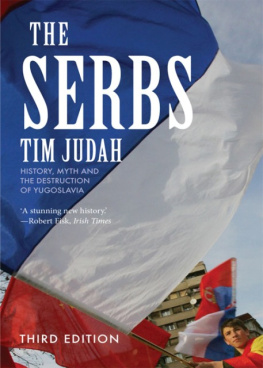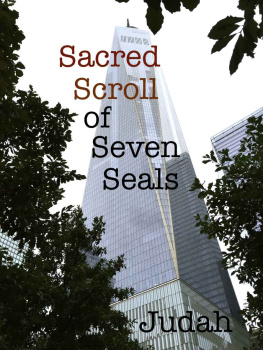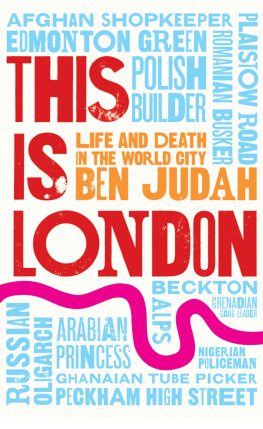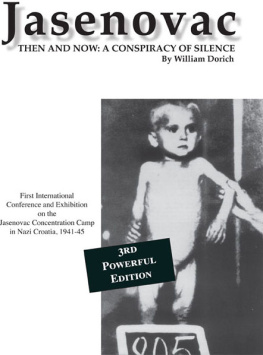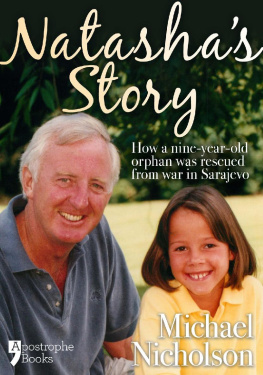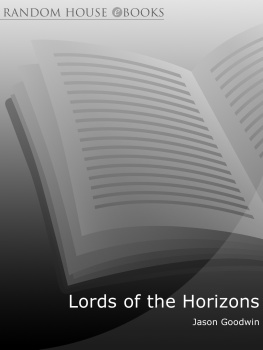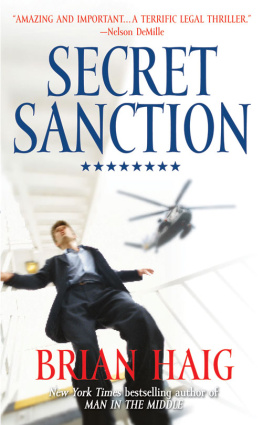
T HE S ERBS
Tim Judah is the Balkans correspondent of The Economist. He has covered the region since 1990 and witnessed many of the recent key events described in this book. He was educated at the London School of Economics and the Fletcher School of Law and Diplomacy at Tufts University. He is the author of Kosovo: War and Revenge (2000), published by Yale University Press, Kosovo: What Everyone Needs to Know (2008), and a biography of the first black African athlete to win an Olympic gold medal, Bikila: Ethiopia's Barefoot Olympian (2008). He has written for many publications including the New York Review of Books, the London Times and the Observer and been a senior visiting research fellow at the European Institute of the London School of Economics. He lives in London with his wife and five children.

For Rosie
Copyright 1997, 2000, 2009 by Tim Judah
First published in 1997
Second edition published in 2000
Third edition published in 2009
All rights reserved. This book may not be reproduced in whole or in part, in any form (beyond that copying permitted by Sections 107 and 108 of the U.S. Copyright Law and except by reviewers for the public press) without written permission from the publishers.
For information about this and other Yale University Press publications,
please contact:
www.yalebooks.com
www.yalebooks.co.uk
U.S. office:
Europe office:
Typeset by SX Composing DTP, Rayleigh, Essex
Printed in Great Britain by TJ International Ltd, Padstow, Cornwall
Library of Congress Cataloging-in-Publication Data
Judah, Tim, 1962
The Serbs: history, myth, and the destruction of Yugoslavia / Tim Judah.
3rd ed.
p. cm.
Includes bibliographical references and index.
ISBN 978-0-300-15826-7 (cl: alk. paper)
1. SerbiaHistory. 2. Yugoslav War, 19911995Serbia. I. Title.
DR1965.J83 2009
949.703dc22
2009039429
10 9 8 7 6 5 4 3 2 1
C ONTENTS
Migrations The Arrival of the Slavs The First Kingdoms The Arrival of the Turks The Military Frontier
Birth of a Dynasty The Holy Roots High Noon of Empire Retreat from Empire
The Battle and its Aftermath Lazar's Choice: The Empire of Heaven The Cult of Death Preserving the Message The Heavenly State
From Pig Dealers to Princes From History into Ideology Creating the New Nationalism
The Burning Tradition Bosnia's Sulphurous Vapours They Are Not Human Beings: The Balkan Wars Instinct and Experience: How Many?
Narodno Jedinstvo: The Birth of National Unity? Sarajevo, 1914 Agony and Resurrection Over There, Far Away: Corfu 1917 The Empire Restored
Decline and Fall Into the Whirlwind Croatia, Kaputt Kosovo: Land of Revenge Frankenstein's Monster
White Lines and Marble Columns Blind Alleys Rankovi and Beyond Croatian Spring Serbian Summer Kosovo: Use Brute Force Bosnian Spirit A Proposal for Hopelessness Antique God Bolshevism Is Bad But Nationalism Is Worse (Radovan Karadi)
Framing the Serbs Goodbye Slovenia, Hello Croatia You Must Have Bloodshed to Make a Country We've Been Here Before! Rusty Shoehorns Half-Time
Which Side Will You Be On? On the Highway to Hell
The Croatian Connection Corridor Life Sarajevo: Serbian Defeat Pale: Fiction Met Reality
Bosanski Novi and the Spare Ribs The Banality of Evil? No One Will Harm You!
The Biha Bazaar and the Human Hens Bosnia: Open for Business BelgradeChicago
The Price We Must Pay Banks, What Banks? The Inflationary Tsunami Surfing the Tsunami Supergrandpa to the Rescue Serbia's Loss, Canada's Gain
Days in Hell The Idea Is on the Table House Hunters
Serbs to Sacrifice Simplifying Matters On Board the Supertanker The Spider's Web
Land of the Living Past From Enver to Rambouillet Isolation Our Nation is a Hero Heavenly People
He's Finished The Vampire King Nikola's Revenge Kosovo is Serbia/Kosovo was Serbia The History Trap
I LLUSTRATIONS
Maps
Tables
Wartime Casualties by Republic, 19415
Populations of BosniaHercegovina, 18751991
P REFACE TO THE N EW E DITION
The problem with history is that it never stops. This book was first published in 1997, written immediately after the end of the Bosnian and Croatian wars which were still fresh in my mind from having just reported them. Then came the Kosovo war of 1998 and 1999 and NATO's seventy-eight-day bombing campaign of what was then still called Yugoslavia. I reported on that and then updated this book for a second edition. Since then a lot of water has flowed under the bridge.
This new edition aims to bring things up to date. In October 2000, in the wake of the Kosovo war, Slobodan Miloevi, the Serbian leader who had led his people to war and disaster, fell. In 2003 Zoran Djindji, the charismatic opposition leader turned prime minister was assassinated. In 2003 the name Yugoslavia was consigned to the rubbish bin of history and in 2006 Montenegro left its federation with Serbia. Both countries were then once more completely independent under their own names, for the first time since 1918.
In 2008 Kosovo declared independence. At the same time Serbia set itself firmly on a course of European integration, but history, and especially relations with the International Criminal Tribunal for the former Yugoslavia (ICTY) in The Hague, held it back.
I lived in Belgrade from 1991 to 1995. After returning to live in London I continued to cover Balkan affairs, travelling frequently to the region. I covered the Kosovo war for, amongst other publications, the Sunday Telegraph, the Guardian's Weekend magazine and the Observer. I also wrote several pieces for the New York Review of Books. In the wake of the Kosovo war, Yale University Press asked me to write a full account of the war and its roots. This is called Kosovo: War and Revenge, and is a companion volume to this one and, given the constraints of space here, discusses the issues at stake in far greater detail.
In 2008, I wrote Kosovo: What Everyone Needs to Know for Oxford University Press. What has kept me most firmly engaged with the region, however, is being Balkans Correspondent for The Economist.
For this edition of the book the text has been completely updated and a new chapter written. A substantial number of books published since the last edition have also been added to the bibliography.
The aim of this book is to give a general reader or student an easily accessible introduction to the subject. However, they should remember that the period I covered as a journalist, that is, the years of the destruction of Yugoslavia and their aftermath, can only be a first draft of history. In future, what will make these years different to any other conflicts to date will be the transcripts and archives of the ICTY, which are a unique record of the war years and accessible to everyone via their website.
P REFACE
In the south, in Kosovo, the medieval churches of the Serbian kings are like rafts on the sea of history. They are like rafts because Kosovo, once a land inhabited by Serbs, is now a land overwhelmingly populated by Albanians. In the 1690s, following an uprising against the Turks, thousands of Serbs migrated northwards and settled in the fertile lands beyond the Danube. When they left they took with them the remains of Lazar, their greatest medieval prince, who had died in 1389.
Next page
